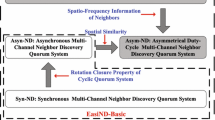Abstract
In wireless sensor networks, much energy is wasted during connecting and control processes. This is particularly true for the neighborhood discovery process carried out in Bluetooth Low Energy (BLE) before the communications between devices. However, the fixed duration of this process has a critical energy cost when the number of neighbors is low or when only a few neighbors are required by the application. In order to address this issue, a novel protocol called WUBBLE is proposed to leverage wake-up radio technology to start and end the discovery process. Wake-up radio enables additional communications between devices with an ultra-low energy overhead. WUBBLE is validated by combining analytical analysis and experimental measurements, and results show that half of the energy could be gained to discover 90% of the neighbors.
Access this chapter
Tax calculation will be finalised at checkout
Purchases are for personal use only
Similar content being viewed by others
References
Core specification 4.0 - bluetooth® technology website (2010). https://www.bluetooth.com/specifications/specs/core-specification-4-0/
Core specification 5.0 - bluetooth® technology website (2016). https://www.bluetooth.com/specifications/specs/core-specification-5-0/
Djidi, N.E.H., Gautier, M., Courtay, A., Berder, O., Magno, M.: How can wake-up radio reduce LoRa downlink latency for energy harvesting sensor nodes? Sensors 21(3), 733 (2021)
Djidi, N.E.H., et al.: The revenge of asynchronous protocols: wake-up radio-based multi-hop multi-channel MAC protocol for WSN. In: IEEE Wireless Communications and Networking Conference (WCNC), Austin, United States (2022)
Ghamari, M., et al.: Detailed examination of a packet collision model for bluetooth low energy advertising mode. IEEE Access 6, 46066–46073 (2018). https://doi.org/10.1109/ACCESS.2018.2866323
Giovanelli, D., Milosevic, B., Brunelli, D., Farella, E.: Enhancing bluetooth low energy with wake-up radios for IoT applications. In: International Wireless Communications and Mobile Computing Conference (IWCMC), pp. 1622–1627 (2017). https://doi.org/10.1109/IWCMC.2017.7986527
Jeon, W.S., Dwijaksara, M.H., Jeong, D.G.: Performance analysis of neighbor discovery process in bluetooth low-energy networks. IEEE Trans. Veh. Technol. 66, 1865–1871 (2017). https://doi.org/10.1109/TVT.2016.2558194
Kindt, P.H., Narayanaswamy, S., Saur, M., Chakraborty, S.: Optimizing BLE-like neighbor discovery. IEEE Trans. Mob. Comput. 21(5), 1779–1797 (2022). https://doi.org/10.1109/TMC.2020.3028270
Kindt, P.H., Saur, M., Balszun, M., Chakraborty, S.: Neighbor discovery latency in BLE-like protocols. IEEE Trans. Mob. Comput. 17(3), 617–631 (2018). https://doi.org/10.1109/TMC.2017.2737008
Liendo Sanchez, A.: Study of adaptation mechanisms of the wireless sensor nodes to the context for ultra-low power consumption. Theses, Université Grenoble Alpes (2018)
Luo, B., Xiang, F., Sun, Z., Yao, Y.: BLE neighbor discovery parameter configuration for IoT applications. IEEE Access 7, 54097–54105 (2019). https://doi.org/10.1109/ACCESS.2019.2912493
Luo, B., Yao, Y., Sun, Z.: Performance analysis models of BLE neighbor discovery: a survey. IEEE Internet Things J. 8, 8734–8746 (2021). https://doi.org/10.1109/JIOT.2020.3046263
Magno, M., Jelicic, V., Srbinovski, B., Bilas, V., Popovici, E., Benini, L.: Design, implementation, and performance evaluation of a flexible low-latency nanowatt wake-up radio receiver. IEEE Trans. Industr. Inf. 12(2), 633–644 (2016). https://doi.org/10.1109/TII.2016.2524982
Mikhaylov, K., Karvonen, H.: Wake-up radio enabled BLE wearables: empirical and analytical evaluation of energy efficiency. In: International Symposium on Medical Information Communication Technology (ISMICT), pp. 1–5 (2020). https://doi.org/10.1109/ISMICT48699.2020.9152699
Shan, G., Choi, G., Roh, B.h., Kang, J.: An improved neighbor discovery process in BLE 5.0. In: 2019 IEEE 10th Annual Information Technology, Electronics and Mobile Communication Conference (IEMCON), pp. 0809–0812. IEEE (2019). https://doi.org/10.1109/IEMCON.2019.8936200
Shan, G., Roh, B.H.: Maximized effective transmission rate model for advanced neighbor discovery process in bluetooth low energy 5.0. IEEE Internet Things J. 4662, 1–13 (2022). https://doi.org/10.1109/JIOT.2022.3152513
Shan, G., Roh, B.H.: Advertisement interval to minimize discovery time of whole BLE advertisers. IEEE Access 6, 17817–17825 (2018). https://doi.org/10.1109/ACCESS.2018.2817343
Shan, G., Roh, B.H.: Performance model for advanced neighbor discovery process in bluetooth low energy 5.0-enabled internet of things networks. IEEE Trans. Ind. Electron. 67, 10965–10974 (2020). https://doi.org/10.1109/TIE.2019.2962401
Wei, L., et al.: Lightning: a high-efficient neighbor discovery protocol for low duty cycle WSNs. IEEE Commun. Lett. 20, 966–969 (2016). https://doi.org/10.1109/LCOMM.2016.2536018
Acknowledgment
This work is part of the project GoodFloow funded by the ADEME. The authors would like to thank the anonymous reviewers for their insightful comments.
Author information
Authors and Affiliations
Corresponding author
Editor information
Editors and Affiliations
Rights and permissions
Copyright information
© 2023 The Author(s), under exclusive license to Springer Nature Switzerland AG
About this paper
Cite this paper
Djidi, N.E.H., Sambo, D.W., Gautier, M., Berder, O., Mitton, N. (2023). WUBBLE: Energy Efficient BLE Neighborhood Discovery Leveraging Wake-Up Radio. In: Georgiou, K., Kranakis, E. (eds) Algorithmics of Wireless Networks. ALGOWIN 2023. Lecture Notes in Computer Science, vol 14061. Springer, Cham. https://doi.org/10.1007/978-3-031-48882-5_6
Download citation
DOI: https://doi.org/10.1007/978-3-031-48882-5_6
Published:
Publisher Name: Springer, Cham
Print ISBN: 978-3-031-48881-8
Online ISBN: 978-3-031-48882-5
eBook Packages: Computer ScienceComputer Science (R0)




